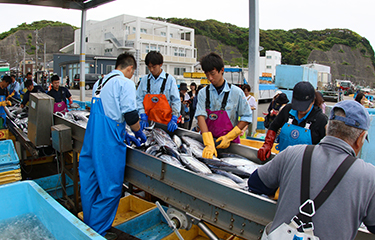Japan recently released a comprehensive white paper on fisheries that contains extensive plans to boost its fisheries and fishing industry in the hopes of reversing negative trends.
Japan’s fishing industry has been in a long decline since the loss of access to the exclusive economic zone (EEZ) of the United States, and a sharp reduction in quota for Russian waters in the early to mid-1980s. Those losses prompted a government-sponsored rationalization fleet reduction. Effort was shifted to sardines in Japanese waters, but the stock soon collapsed, never to return to such high levels.
The number employed in fishing has also been declining. In order to boost employment and ensure successors to the current aging workforce, the government aims to raise incomes of the fisheries industry and make it attractive for the young people.
Part of those efforts involves improving the monitoring of the fisheries. To better measure fish stocks, the government will start to employ satellites and seawater temperature monitors. Additionally, in order to move toward real-time data, the Fisheries Agency will establish standardized electronic data reporting formats.
A new Fisheries Resources Research Center was established at the National Research and Development Agency for Fisheries Research and Education. Part of the purpose for this was to separate stock assessment from policy determination, so as to provide more objectivity and transparency. The information will also be published in a form that is easier for the general public to understand.
The agency intends to convert management of 80 percent of the catch to a total allowable catch (TAC) system by the year 2023, and to allocate the TAC by individual quota (IQ). When implementing a resource management plan, the government will utilize subsidies to stabilize the income of fishermen.
The white paper also includes new plans for poaching – particularly for sea cucumbers, a valuable export item. The government will work to prevent undocumented product from being distributed to markets or from being exported.
Regarding conservation of eels, another popular species that can face conservation issues, Japan will continue to work with China, South Korea, and Taiwan to limit the amount of glass eels that can be placed in aquaculture ponds, and aim to create a legally binding international framework. China has so far resisted a legal limit.
In response to frequent disasters, such as typhoons, the white paper also indicates that a reserve fund will be contributed to by fishermen, and used to maintain income following a disaster or reduction in fishing for resource recovery. Additional funds will be available for replacing income lost due to the novel coronavirus.
In the spirit of preventing disasters, satellite identification and automatic observation equipment will be used for early prediction of red tide to prevent damage to aquaculture. The relation of nutrient salt levels (nitrogen, phosphates, etc.) to marine resources will also be further investigated and managed, to the same ends.
The paper also has plans on the supply chain side. In order to free up markets, changes to Japan’s “Wholesale Market Law” were implemented in June, liberalizing some of the rules restricting the operation of wholesale markets – such as allowing more diversification of items handled, and easier certification of participants. It is part of an effort to respond to declining volumes at the markets, as more product is sold direct from producers to major retailers and restaurant chains.
At large fishing ports where exports are expected to expand, to maintain consistent hygiene and cold-chain the Fishery Agency will promote the integrated development of quays, cargo handling areas, freezing and refrigerating facilities, and ice making facilities necessary for collection and shipping. This is to satisfy requirements for HACCP quality control systems for exports to the U.S.A. and E.U.
In line with the revision of the Fisheries Act, which was approved in 2018, private companies will be able to gain access rights to aquaculture grounds that preferentially reserved for fishery cooperatives. In practice, the Fisheries Agency will try to help the two work together, matching companies with capital to invest with cooperatives to form joint ventures.
The new white paper also contains plans to increase gender diversity in workplaces. Women will be trained and encouraged to take part in the management of fishery cooperatives. Currently there are no female directors of coops. They will be supported to learn skills to manage shops, cafeterias and develop new products.
The paper also goes over how the country plans to tackle nuisance and invasive species. In inland waters, excessive numbers of cormorants have become a nuisance, and the government aims to cull them by half. For exotic or invasive fish (e.g. bass, bluegill) in inland waters, electric shocker boats will be deployed to destroy them.
Among R&D projects, the Fisheries Agency will develop non-destructive analysis of quality, such as fat content and freshness, and methods for determining the origin of seafood.
Photo courtesy of Dane Gillett/Shutterstock







